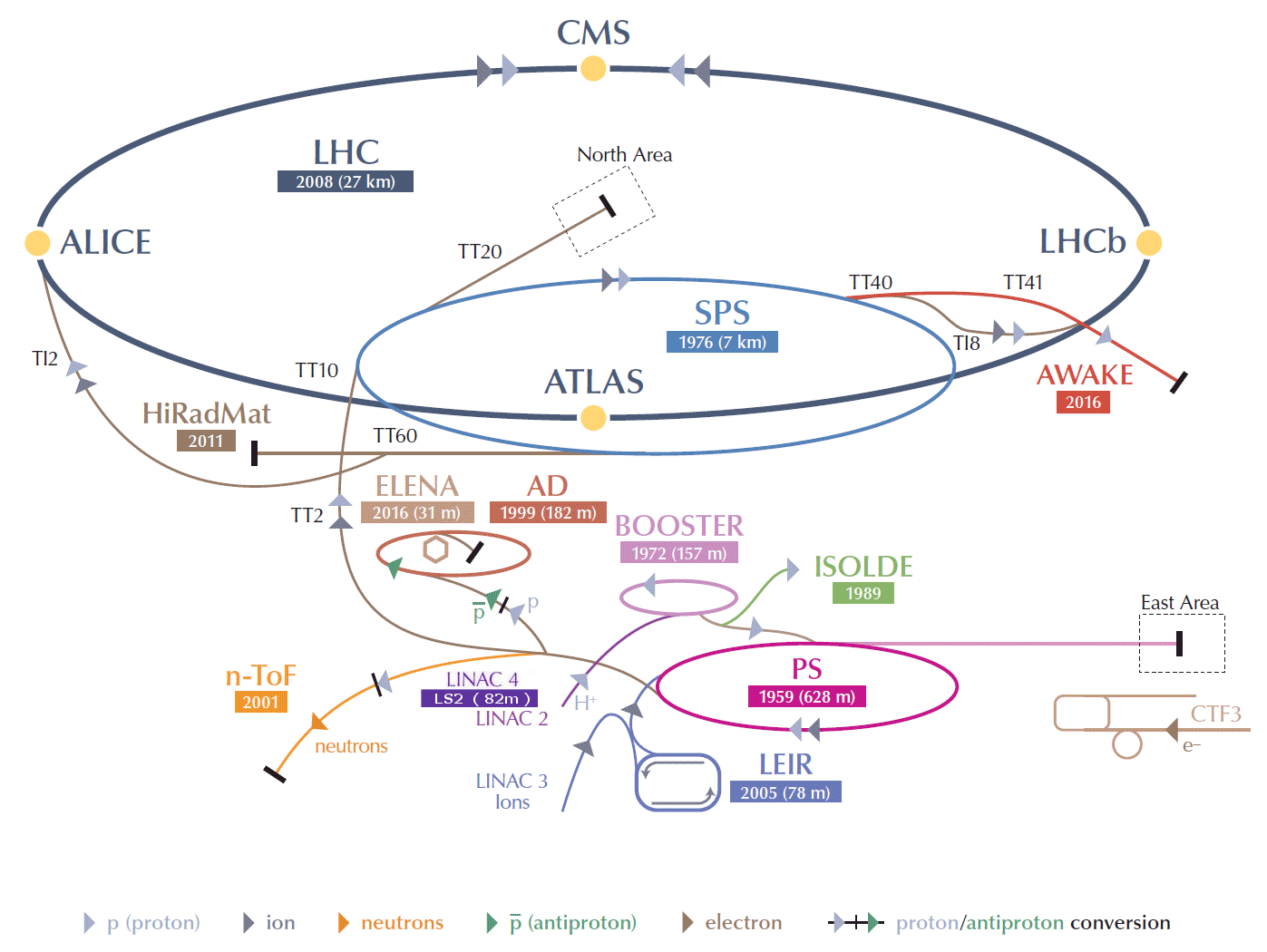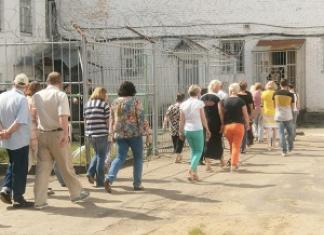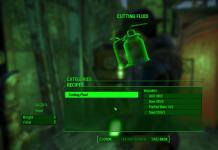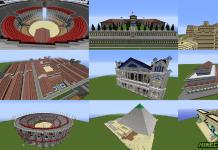Today is the beginning of a revolution in world science. CERN will include the largest, most expensive and powerful complex of scientific equipment in the world - the Large Hadron Collider. The excitement associated with its launch gripped the entire planet - including people far from science. Many are panicking, claiming that launching a facility that would use seven times the energy of the most powerful accelerators could create a black hole or produce antimatter that could completely destroy the Earth.
Some such “enthusiasts” even filed a complaint with the European Court of Human Rights. They claim that “in preparation for the launch of the accelerator, standard procedures provided, in particular, for the commissioning of nuclear power plants” were not followed. However, humanity has vast experience in building accelerators. Despite the fact that the launch of each of them was associated with mass hysteria, not a single such device led to any destruction or casualties.
It must be said that CERN scientists do not deny that black holes can form as a result of the work of the collider. Only very small ones - weighing less than a billionth of a gram. In addition, they “live” only for the smallest fractions of a second. Therefore, experiments with black holes do not pose any danger to the employees of CERN, Geneva, and even more so to the Earth.
If we talk about the LHC, then in the first days after launch it is not turned on at full capacity. The first beams of protons will pass through it at very low power. The accelerator will start working at full capacity only if everything goes well. In addition, long before the collider - like any other accelerator - begins to be built, scientists, naturally, first of all worry about its reliability and safety. Thus, all possible threats that the work of the LHC could lead to were analyzed and prevented many years ago by a special international commission. By the way, they are much less effective than the threat of turning the Earth into a space object made of antimatter or a black hole.
However, no one argues that after the collider starts working with an unprecedented energy of 14 TeV, the world will never be the same. For example, an information explosion on the Internet is absolutely inevitable. Because every second an incredible amount of data will be received from the collider, and thanks to the revolutionary “middleware” software and the Grid system, it will be available to every physicist. Even before the current year ends, the LHC will begin delivering the volume of information equal to one DVD (5 gigabytes) every five seconds. And the annual result of its activities - 15 petabytes (15 million gigabytes) - will surpass any other experiment in the history of science in terms of the amount of data obtained. In this regard, the collider will become an inexhaustible source of new knowledge that, like a tsunami, will pour into the World Wide Web. However, this, like the work of the collider itself, is not dangerous for either people or computers.
The launch of the collider will also put the modern views of physicists under threat. There will be a final and decisive experimental test of the Standard Model - a set of physical theories that explain the “behavior” of elementary particles. If scientists do not yet find its hypothetical, but important element - the Higgs bosons - the Standard Model will have to be revised. But the restructuring (as well as the confirmation) of the physical theories accepted in our time is unlikely to become a tragedy for anyone. Scientists are never afraid of losing faith because they always stand in the way of doubt.
The revolution will occur as a result of the splitting of protons inside a 27-kilometer ring located at a depth of 100 meters. By studying nuclear debris, scientists intend not only to confirm or disprove the existence of Higgs bosons, but also to uncover the mystery of antimatter and “dark matter” - not yet discovered particles that make up most of the mass of the Universe. In addition, the collider will make it possible to study in detail quark-gluon plasma - that is, the state of matter in which it was in the first moments of the Big Bang.
And finally, it’s probably worth noting that the LHC was created as part of an international project in which our country took an active part. More than 50 scientific institutes and enterprises of the Russian Federation participated in the project. Among them are such famous scientific centers as the National Research Center "Kurchatov Institute", the Novosibirsk Institute of Nuclear Physics named after G.I. Budker, the Institute of High Energy Physics, the Institute of Theoretical and Experimental Physics, Moscow State University, MEPhI, Russian nuclear centers in Sarov and Snezhinsk. Many parts of unique equipment were created at our enterprises, including NPO Luch from Podolsk, Myasishchev Design Bureau, NIKIET, which, according to the decision of the CERN jury, were awarded gold medals as the best manufacturers. Foreign participants in the project - the best scientific centers and enterprises in Europe and Asia - as we know, did not disappoint either. Thus, through joint efforts, a never-before-seen device is not only well thought out, but also well executed. This once again proves that no accidents can be expected from him.
The phrase “Large Hadron Collider” has become so deeply entrenched in the media that an overwhelming number of people know about this installation, including those whose activities are in no way connected with the physics of elementary particles, or with science in general.
Indeed, such a large-scale and expensive project could not be ignored by the media - a ring installation almost 27 kilometers long, costing tens of billions of dollars, with which several thousand scientists from all over the world work. A significant contribution to the popularity of the collider was made by the so-called “God particle” or Higgs boson, which was successfully advertised and for which Peter Higgs received the Nobel Prize in Physics in 2013.

First of all, it should be noted that the Large Hadron Collider was not built from scratch, but arose on the site of its predecessor, the Large Electron-Positron collider (LEP). Work on the 27-kilometer tunnel began in 1983, where it was later planned to locate an accelerator that would collide electrons and positrons. In 1988, the ring tunnel closed, and the workers approached the tunneling so carefully that the discrepancy between the two ends of the tunnel was only 1 centimeter.

The accelerator operated until the end of 2000, when it reached its peak energy of 209 GeV. After this, its dismantling began. Over the eleven years of its operation, LEP brought a number of discoveries to physics, including the discovery of W and Z bosons and their further research. Based on the results of these studies, it was concluded that the mechanisms of electromagnetic and weak interactions are similar, as a result of which theoretical work began on combining these interactions into the electroweak.
In 2001, construction of the Large Hadron Collider began on the site of the electron-positron accelerator. Construction of the new accelerator was completed at the end of 2007. It was located at the LEP site - on the border between France and Switzerland, in the valley of Lake Geneva (15 km from Geneva), at a depth of one hundred meters. In August 2008, tests of the collider began, and on September 10, the official launch of the LHC took place. As with the previous accelerator, construction and operation of the facility is led by the European Organization for Nuclear Research - CERN.

CERN

It is worth mentioning briefly about the CERN organization (Conseil Européenne pour la Recherche Nucléaire). This organization acts as the world's largest laboratory in the field of high energy physics. Includes three thousand permanent employees, and several thousand more researchers and scientists from 80 countries take part in CERN projects.
At the moment, there are 22 countries participating in the project: Belgium, Denmark, France, Germany, Greece, Italy, the Netherlands, Norway, Sweden, Switzerland, Great Britain - founders, Austria, Spain, Portugal, Finland, Poland, Hungary, Czech Republic, Slovakia, Bulgaria and Romania – acceded. However, as mentioned above, several dozen more countries take part in the work of the organization in one way or another, and in particular at the Large Hadron Collider.
How does the Large Hadron Collider work?
What is the Large Hadron Collider and how it works are the main questions of public interest. Let's look at these questions further.
Collider – translated from English means “one who collides.” The purpose of such a setup is to collide particles. In the case of the hadron collider, the particles are played by hadrons - particles participating in strong interactions. These are protons.
Getting protons
The long journey of protons originates in the duoplasmatron - the first stage of the accelerator, which receives hydrogen in the form of gas. A duoplasmatron is a discharge chamber where an electrical discharge is conducted through a gas. So hydrogen, consisting of only one electron and one proton, loses its electron. In this way, plasma is formed - a substance consisting of charged particles - protons. Of course, it is difficult to obtain pure proton plasma, so the resulting plasma, which also includes a cloud of molecular ions and electrons, is filtered to isolate the proton cloud. Under the influence of magnets, proton plasma is knocked into a beam.

Preliminary acceleration of particles
The newly formed proton beam begins its journey in the LINAC 2 linear accelerator, which is a 30-meter ring sequentially hung with several hollow cylindrical electrodes (conductors). The electrostatic field created inside the accelerator is graded in such a way that particles between the hollow cylinders always experience an accelerating force in the direction of the next electrode. Without delving entirely into the proton acceleration mechanism at this stage, we only note that at the output from LINAC 2, physicists receive a beam of protons with an energy of 50 MeV, which already reaches 31% of the speed of light. It is noteworthy that in this case the mass of particles increases by 5%.

By 2019-2020, it is planned to replace LINAC 2 with LINAC 4, which will accelerate protons to 160 MeV.
It is worth noting that the collider also accelerates lead ions, which will make it possible to study quark-gluon plasma. They are accelerated in the LINAC 3 ring, similar to LINAC 2. In the future, experiments with argon and xenon are also planned.
Next, the proton packets enter the proton synchronous booster (PSB). It consists of four superimposed rings with a diameter of 50 meters, in which electromagnetic resonators are located. The electromagnetic field they create has a high intensity, and a particle passing through it receives acceleration as a result of the field potential difference. So, after just 1.2 seconds, the particles are accelerated in the PSB to 91% of the speed of light and reach an energy of 1.4 GeV, after which they enter the proton synchrotron (PS). The PS is 628 meters in diameter and is equipped with 27 magnets that direct the particle beam in a circular orbit. Here the particle protons reach 26 GeV.

The penultimate ring for accelerating protons is the Super Proton Synchrotron (SPS), the circumference of which reaches 7 kilometers. Equipped with 1317 magnets, the SPS accelerates particles to an energy of 450 GeV. After about 20 minutes, the proton beam enters the main ring - the Large Hadron Collider (LHC).

Acceleration and collision of particles in the LHC
Transitions between accelerator rings occur through electromagnetic fields created by powerful magnets. The collider's main ring consists of two parallel lines in which particles move in a circular orbit in the opposite direction. About 10,000 magnets are responsible for maintaining the circular trajectory of the particles and directing them to the collision points, some of them weighing up to 27 tons. To avoid overheating of the magnets, a helium-4 circuit is used, through which approximately 96 tons of the substance flows at a temperature of -271.25 ° C (1.9 K). Protons reach an energy of 6.5 TeV (that is, the collision energy is 13 TeV), while their speed is 11 km/h less than the speed of light. Thus, in a second, a beam of protons passes through the large ring of the collider 11,000 times. Before the particles collide, they will circulate around the ring for 5 to 24 hours.

Particle collisions occur at four points in the main LHC ring, where four detectors are located: ATLAS, CMS, ALICE and LHCb.
Large Hadron Collider detectors
ATLAS (A Toroidal LHC Apparatus)

— is one of two general purpose detectors at the Large Hadron Collider (LHC). He explores a wide range of physics, from the search for the Higgs boson to the particles that may make up dark matter. Although it has the same scientific goals as the CMS experiment, ATLAS uses different technical solutions and a different magnetic system design.

Beams of particles from the LHC collide at the center of the ATLAS detector, creating oncoming debris in the form of new particles that fly out from the collision point in all directions. Six different detection subsystems, arranged in layers around the point of impact, record the path, momentum and energy of the particles, allowing them to be individually identified. A huge system of magnets bends the paths of charged particles so that their impulses can be measured.
The interactions in the ATLAS detector create a huge flow of data. To process this data, ATLAS uses an advanced "trigger" system to tell the detector which events to record and which to ignore. Sophisticated data acquisition and calculation systems are then used to analyze the recorded collision events.

The detector is 46 meters high and 25 meters wide, while its mass is 7,000 tons. These parameters make ATLAS the largest particle detector ever built. It is located in a tunnel at a depth of 100 m near the main site of CERN, near the village of Meyrin in Switzerland. The installation consists of 4 main components:
- The inner detector has a cylindrical shape, the inner ring is located just a few centimeters from the axis of the passing particle beam, and the outer ring has a diameter of 2.1 meters and a length of 6.2 meters. It consists of three different sensor systems immersed in a magnetic field. An internal detector measures the direction, momentum and charge of the electrically charged particles produced in each proton-proton collision. The main elements of the internal detector are: a Pixel Detector, a Semi-Conductor Tracker (SCT) and a Transition radiation tracker (TRT).

- Calorimeters measure the energy that a particle loses as it passes through a detector. It absorbs particles arising during a collision, thereby recording their energy. Calorimeters consist of layers of high-density “absorbing” material—lead—alternating with layers of “active medium”—liquid argon. Electromagnetic calorimeters measure the energy of electrons and photons as they interact with matter. Hadron calorimeters measure the energy of hadrons when they interact with atomic nuclei. Calorimeters can stop most known particles except muons and neutrinos.

LAr (Liquid Argon Calorimeter) - ATLAS calorimeter
- Muon Spectrometer - consists of 4000 individual muon chambers using four different technologies to identify muons and measure their momenta. Muons typically pass through an internal detector and calorimeter, requiring a muon spectrometer.

- ATLAS's magnetic system bends particles around different layers of detector systems, making it easier to track particle tracks.

The ATLAS experiment (February 2012) involves more than 3,000 scientists from 174 institutions in 38 countries.
CMS (Compact Muon Solenoid)

— is a general purpose detector at the Large Hadron Collider (LHC). Like ATLAS, it has a broad physics program, ranging from studying the standard model (including the Higgs boson) to searching for particles that may make up dark matter. Although it has the same scientific goals as the ATLAS experiment, CMS uses different technical solutions and a different magnetic system design.

The CMS detector is built around a huge solenoid magnet. It is a cylindrical coil of superconducting cable that generates a 4 Tesla field, approximately 100,000 times the Earth's magnetic field. The field is limited by a steel “yoke”, which is the most massive component of the detector, weighing 14,000 tons. The complete detector is 21 m long, 15 m wide and 15 m high. The installation consists of 4 main components:
- The solenoid magnet is the largest magnet in the world and serves to bend the trajectory of charged particles emitted from the point of impact. Trajectory distortion makes it possible to distinguish between positively and negatively charged particles (since they bend in opposite directions), as well as to measure momentum, the magnitude of which depends on the curvature of the trajectory. The huge size of the solenoid allows the tracker and calorimeters to be located inside the coil.
- Silicon Tracker - Consists of 75 million individual electronic sensors arranged in concentric layers. When a charged particle flies through the layers of the tracker, it transfers part of the energy to each layer; combining these points of collision of the particle with different layers allows us to further determine its trajectory.
- Calorimeters – electron and hadronic, see ATLAS calorimeters.
- Sub-detectors - allow you to detect muons. They are represented by 1,400 muon chambers, which are located in layers outside the coil, alternating with metal plates of the “yoke”.

The CMS experiment is one of the largest international scientific studies in history, involving 4,300 people: particle physicists, engineers and technicians, students and support staff from 182 institutions, 42 countries (February 2014).
ALICE (A Large Ion Collider Experiment)

— is a heavy ion detector on the rings of the Large Hadron Collider (LHC). It is designed to study the physics of strongly interacting matter at extreme energy densities, where a phase of matter called quark-gluon plasma is formed.
All ordinary matter in today's universe is made of atoms. Each atom contains a nucleus of protons and neutrons (except hydrogen, which has no neutrons), surrounded by a cloud of electrons. Protons and neutrons, in turn, are made of quarks bound together with other particles called gluons. No quark has ever been observed in isolation: quarks, as well as gluons, appear to be permanently bound together and confined within constituent particles such as protons and neutrons. This is called confinement.

Collisions in the LHC create temperatures more than 100,000 times hotter than at the center of the Sun. The collider enables collisions between lead ions, recreating conditions similar to those that occurred immediately after the Big Bang. Under these extreme conditions, protons and neutrons “melt,” freeing the quarks from their bonds with gluons. This is quark-gluon plasma.
The ALICE experiment uses the ALICE detector, which weighs 10,000 tons, is 26 m long, 16 m high and 16 m wide. The device consists of three main sets of components: tracking devices, calorimeters and particle identifier detectors. It is also divided into 18 modules. The detector is located in a tunnel at a depth of 56 m below, near the village of Saint-Denis-Pouilly in France.

The experiment includes more than 1,000 scientists from more than 100 physics institutes in 30 countries.
LHCb (Large Hadron Collider beauty experiment)

– The experiment explores small differences between matter and antimatter by studying a type of particle called a beauty quark or b quark.
Instead of surrounding the entire collision point with a closed detector, like ATLAS and CMS, the LHCb experiment uses a series of subdetectors to detect predominantly forward particles—those that were pointed forward by a collision in one direction. The first sub-detector is installed close to the collision point, and the others are installed one after the other at a distance of 20 meters.

The LHC creates a large abundance of different types of quarks before they quickly decay into other forms. To catch b quarks, complex moving tracking detectors were developed for LHCb, located close to the movement of the particle beam through the collider.
The 5,600-ton LHCb detector consists of a direct spectrometer and flat-plate detectors. It is 21 meters long, 10 meters high and 13 meters wide, and is located 100 meters underground. About 700 scientists from 66 different institutes and universities are involved in the LHCb experiment (October 2013).

Other experiments at the collider
In addition to the above experiments at the Large Hadron Collider, there are two other experiments with installations:
- LHCf (Large Hadron Collider forward)— studies particles thrown forward after the collision of particle beams. They simulate cosmic rays, which scientists are studying as part of the experiment. Cosmic rays are naturally occurring charged particles from outer space that constantly bombard the earth's atmosphere. They collide with nuclei in the upper atmosphere, causing a cascade of particles that reach ground level. Studying how collisions inside the LHC produce such particle cascades will help physicists interpret and calibrate large-scale cosmic ray experiments that can span thousands of kilometers.

LHCf consists of two detectors that are located along the LHC, 140 meters away on either side of the ATLAS impact point. Each of the two detectors weighs just 40 kilograms and measures 30 cm long, 80 cm high and 10 cm wide. The LHCf experiment involves 30 scientists from 9 institutes in 5 countries (November 2012).
- TOTEM (Total Cross Section, Elastic Scattering and Diffraction Dissociation)- an experiment with the longest installation on the collider. Its mission is to study protons themselves, by precisely measuring protons produced in low-angle collisions. This region is known as the "forward" direction and is not accessible to other LHC experiments. TOTEM detectors extend almost half a kilometer around the CMS interaction point. TOTEM has almost 3,000 kg of equipment, including four nuclear telescopes, as well as 26 Roman pot detectors. The latter type allows detectors to be positioned as close as possible to the particle beam. The TOTEM experiment includes approximately 100 scientists from 16 institutes in 8 countries (August 2014).

Why is the Large Hadron Collider needed?
The largest international scientific installation explores a wide range of physical problems:
- Study of top quarks. This particle is not only the heaviest quark, but also the heaviest elementary particle. Studying the properties of the top quark also makes sense because it is a research tool.
- Search and study of the Higgs boson. Although CERN claims that the Higgs boson has already been discovered (in 2012), very little is known about its nature and further research could bring greater clarity to the mechanism of its operation.

- Study of quark-gluon plasma. When lead nuclei collide at high speeds, . is formed in the collider. Her research can bring results useful both for nuclear physics (improving the theory of strong interactions) and astrophysics (studying the Universe in its first moments of existence).
- Search for supersymmetry. This research aims to disprove or prove “supersymmetry,” the theory that every elementary particle has a heavier partner called a “superparticle.”
- Study of photon-photon and photon-hadron collisions. It will improve the understanding of the mechanisms of processes of such collisions.
- Testing exotic theories. This category of tasks includes the most unconventional - “exotic” ones, for example, the search for parallel universes by creating mini-black holes.
In addition to these tasks, there are many others, the solution of which will also allow humanity to understand nature and the world around us at a better level, which in turn will open up opportunities for the creation of new technologies.
Practical benefits of the Large Hadron Collider and fundamental science
First of all, it should be noted that basic research contributes to basic science. Applied science deals with the application of this knowledge. A segment of society that is not aware of the benefits of fundamental science often does not perceive the discovery of the Higgs boson or the creation of quark-gluon plasma as something significant. The connection of such studies with the life of an ordinary person is not obvious. Let's look at a short example with nuclear energy:
In 1896, French physicist Antoine Henri Becquerel discovered the phenomenon of radioactivity. For a long time it was believed that humanity would not switch to its industrial use soon. Just five years before the launch of the first nuclear reactor in history, the great physicist Ernest Rutherford, who actually discovered the atomic nucleus in 1911, said that atomic energy would never find its application. Experts managed to rethink their attitude to the energy contained in the nucleus of an atom in 1939, when German scientists Lise Meitner and Otto Hahn discovered that uranium nuclei, when irradiated with neutrons, split into two parts, releasing a huge amount of energy - nuclear energy.
And only after this last link in a series of fundamental research did applied science come into play, which, on the basis of these discoveries, invented a device for producing nuclear energy - an atomic reactor. The scale of the discovery can be assessed by looking at the share of electricity generated by nuclear reactors. So in Ukraine, for example, nuclear power plants account for 56% of electricity generation, and in France – 76%.
All new technologies are based on certain fundamental knowledge. Here are a couple more brief examples:
- In 1895, Wilhelm Conrad Roentgen noticed that when exposed to X-rays, a photographic plate darkens. Today, radiography is one of the most used examinations in medicine, allowing one to study the condition of internal organs and detect infections and swellings.
- In 1915, Albert Einstein proposed his own. Today, this theory is taken into account when operating GPS satellites, which determine the location of an object with an accuracy of a couple of meters. GPS is used in cellular communications, cartography, transport monitoring, but primarily in navigation. The error of a satellite that does not take into account general relativity would grow by 10 kilometers per day from the moment of launch! And if a pedestrian can use his mind and a paper map, then airline pilots will find themselves in a difficult situation, since it is impossible to navigate by clouds.

If today a practical application for the discoveries made at the LHC has not yet been found, this does not mean that scientists are “tinkering at the collider in vain.” As you know, a reasonable person always intends to obtain the maximum practical application from existing knowledge, and therefore the knowledge about nature accumulated in the process of research at the LHC will definitely find its application, sooner or later. As has already been demonstrated above, the connection between fundamental discoveries and the technologies that use them may sometimes not be at all obvious.
Finally, let us note the so-called indirect discoveries, which are not set as the initial goals of the study. They occur quite often, since making a fundamental discovery usually requires the introduction and use of new technologies. Thus, the development of optics received an impetus from fundamental space research, based on observations by astronomers through a telescope. In the case of CERN, this is how a ubiquitous technology emerged: the Internet, a project proposed by Tim Berners-Lee in 1989 to make CERN organization data easier to find.
5 (100%) 1 vote[s]
The Large Hadron Collider, the world's most powerful particle accelerator, which is being tested at the European Organization for Nuclear Research (CERN), became the subject of a lawsuit even before its launch. Who sued scientists and why?
Don't judge the Large Hadron Collider... Residents of the state of Hawaii Walter Wagner and Luis Sancho filed a lawsuit in the federal district court of Honolulu against CERN, as well as the American participants in the project - the Department of Energy, the National Science Foundation and the Fermi National Accelerator Laboratory for this reason.
⦳⦳⦳⦳⦳
American citizens feared that the collisions of hugely energetic subatomic particles that would be carried out in an accelerator to simulate the events that took place in the Universe in the first moments after the Big Bang, can create objects threatening the existence of the Earth.
Large Hadron Collider at Cern. In the frame is a simulation of the Higgs boson production process in the CMS detector
The danger, according to the plaintiffs, comes primarily from so-called black holes - physical objects that can absorb some of the objects on our planet - for example, some large city.
Despite the fact that the lawsuit was filed in court in early April 2008, experts did not at all treat it as an April Fool's joke.
And on April 6, they organized an open day at the Nuclear Research Center, inviting members of the public, journalists, students and schoolchildren to a tour of the accelerator, so that they could not only see the unique scientific instrument with their own eyes, but also receive comprehensive answers to all their questions.
First of all, of course, the organizers of the project tried to convince visitors that the LHC could not in any way become the culprit of the “end of the world.”

Yes, located in a circular tunnel with a circumference of 27 km, the collider (from the English collide - “collide”) is capable of accelerating proton beams and colliding them with an energy of up to 14 teraelectronvolts 40 million times per second.
Physicists believe it will be possible to recreate the conditions that arose one trillionth of a second after the Big Bang, and thus obtain valuable information about the very beginning of the Universe.

Large Hadron Collider and black hole
But CERN representative James Gills expressed great doubts about the possibility that a black hole would appear in this case or something completely unknown. And not only because the safety assessment of the collider is constantly carried out by theorists, but also simply based on practice.
“An important argument that CERN’s experiments are safe is the very existence of the Earth,” he said.
– Our planet is constantly exposed to streams of cosmic radiation, the energy of which is not inferior to, and often exceeds, that of Cernov, and has not yet been destroyed either by a black hole or other reasons.
Meanwhile, as we have calculated, during the existence of the Universe, nature has completed at least 1031 programs similar to the one that we are just about to implement”...

He does not see any particular danger in the possibility of an uncontrolled annihilation reaction involving antiparticles that arise as a result of experiments.
“They actually produce antimatter at CERN,– the scientist confirmed in an interview with New Scientist magazine.
“However, those crumbs that can be artificially created on Earth would not be enough for even the smallest bomb.”
It is extremely difficult to store and accumulate antimatter (and some of its types are completely impossible)”...

Large Hadron Collider and boson
Search for the boson. By the way, the same magazine wrote that Russian experts - Professor Irina Arefieva and Doctor of Physical and Mathematical Sciences Igor Volovich from the Steklov Mathematical Institute in Moscow - believe that a large-scale experiment at CERN could lead to the appearance of the first... time machine in the world.
I asked Professor Irina Yaroslavovna Arefieva to comment on this message. And this is what she said:
“We still know quite little about the structure of the world around us. Remember, the ancient Greeks believed that all objects were made of atoms, which means “indivisible” in Greek.
However, over time it became clear that the atoms themselves have a rather complex structure, consisting of electrons, protons and neutrons. In the first half of the 20th century, it suddenly turned out that the same electrons with protons and neutrons, in turn, can be divided into a number of particles.
At first they were recklessly called elementary. However, it is now becoming clear that many of these so-called elementary particles can, in turn, divide...

In general, when theorists tried to combine all the knowledge gained within the framework of the so-called Standard Model, it turned out that its central link, according to some data, is the Higgs bosons.”
The mysterious particle got its name from Professor Peter Higgs from the University of Edinburgh. Unlike Professor Higgins from the famous musical, he was not engaged in teaching the correct pronunciation of pretty girls, but in learning the laws of the microworld.
And back in the 60s of the last century he made the following assumption: “The Universe is not at all empty, as it seems to us.
Its entire space is filled with a certain viscous substance, through which, for example, gravitational interaction between celestial bodies is carried out, ranging from particles, atoms and molecules to planets, stars and galaxies.”

To put it quite simply, P. Higgs suggested returning to the idea "worldwide broadcast" which was once already rejected. But since physicists, like other people, do not like to admit their mistakes, the new-old substance is now called "Higgs field".
And now it is believed that it is this force field that gives mass to nuclear particles. And their mutual attraction is ensured by the carrier of gravity, which was first called the graviton, and now the Higgs boson.
In 2000, physicists thought they had finally “caught” the Higgs boson. However, a series of experiments undertaken to test the first experiment showed that the boson had escaped again. Nevertheless, many scientists are confident that the particle still exists.
And to catch it, you just need to build more reliable traps and create even more powerful accelerators. One of the most ambitious instruments of mankind was built by universal efforts at CERN near Geneva.

However, the Higgs boson is caught not only to verify the validity of scientists’ predictions, but also to find another candidate for the role of “the first building block of the Universe.”
« There are, in particular, exotic assumptions about the structure of the Universe,
– Professor I.Ya continued her story. Arefieva.
– Traditional theory says that we live in a four-dimensional world
– three spatial coordinates plus time.
Large Hadron Collider measurement theory
But there are hypotheses suggesting that in fact there are more dimensions - six or ten, or even more. In these dimensions, the force of gravity can be significantly higher than the g we are used to.
And gravity, according to Einstein's equations, can influence the passage of time. This is where the hypothesis arose “time machine”. But even if it exists, it will be for a very short time and in a very small volume”...

Equally exotic, according to Irina Yaroslavovna, is the hypothesis about the formation of colliding beams miniature black holes. Even if they are formed, their lifetime will be so insignificant that they will be extremely difficult to simply detect.
Only by indirect evidence, for example, Hawking's X-ray radiation, and even then after the hole itself disappears.
In short, the reactions, according to some calculations, will occur in a volume of only 10–20 cubic meters. cm and so quickly that experimenters will have to rack their brains to put the right sensors in the right places, obtain the data and then interpret it accordingly.

To be continued… From the time when Professor Arefieva said the above words, almost five years passed until these lines were written.
During this time, not only the first test launch of the LHC took place, but also several subsequent ones. As you now know, everyone remained alive, and nothing terrible happened. Work continues...
Scientists only complain that it is very difficult for them to monitor the serviceability of all the equipment of this unique scientific installation. Nevertheless, they are already dreaming of building a giant next-generation particle accelerator - the International Linear Collider (ILC).

CERN, Switzerland. June 2013.
In any case, this is what Barry Barish, emeritus professor at the California Institute of Technology, who is leading the design of the International Linear Collider, and his colleagues write about this
– Nicholas Walker Walker, an accelerator physicist from Hamburg, and Hitoshi Yamamoto, a professor of physics at Tohoku University in Japan.

Large Hadron Collider of the future
“ILC designers have already determined the main parameters of the future collider,” the scientists report.
– Its length is approx. 31 km; the main part will be occupied by two superconducting linear accelerators, which will provide electron-positron collisions with an energy of 500 GeV.
Five times per second, the ILC will generate, accelerate and collide nearly 3,000 electron and positron bunches in a 1-ms pulse, corresponding to 10 MW of power for each beam.
The efficiency of the installation will be about 20%, therefore the total power that ILC will need to accelerate particles will be almost 100 MW.”

To create a beam of electrons, a gallium arsenide target will be irradiated with a laser; in this case, in each pulse, billions of electrons will be knocked out of it.
These electrons will be immediately accelerated to 5 GeV in a short linear superconducting accelerator and then injected into a 6.7-kilometer storage ring located at the center of the complex.
Moving in the ring, electrons will generate synchrotron radiation, and the bunches will compress, which will increase the charge density and beam intensity.
Halfway through, at an energy of 150 MeV, the electron bunches will be slightly deflected and directed into a special magnet, the so-called undulator, where some of their energy will be converted into gamma radiation.
The gamma-ray photons will hit a titanium alloy target rotating at about 1,000 revolutions per minute.

In this case, many electron-positron pairs are formed. The positrons will be captured, accelerated to 5 GeV, after which they will fall into another compression ring and, finally, into the second main linear superconducting accelerator at the opposite end of the LS.
When the energy of electrons and positrons reaches a final value of 250 GeV, they will rush to the collision point. After the collision, the reaction products will be directed into traps, where they will be recorded.
Large Hadron Collider video
The largest and most powerful particle accelerator in the world - the Large Hadron Collider (LHC) - recently returned to work. After the upgrade, the particle accelerator began working with double power. Does this mean that all the fears associated with its initial launch have been revived with a vengeance?
Although this event was anticipated around the world, there were two people who remained silent: Walter Wagner, a retired nuclear safety officer, and Spanish journalist Luis Sancho. They have their own history associated with the LHC, and perhaps we owe it to them for all the horror stories associated with the launch of a proton-splitting machine.
Months before the collider was set to turn on for the first time in 2008, Wagner and Sancho filed a lawsuit against the organizations behind the monster machine: the US Department of Energy, the Fermi National Accelerator Laboratory and the National Science Foundation.
It goes without saying that it took a lot of courage and perhaps a little madness to try to sue any of these organizations that employ some of humanity's brightest intellectuals, let alone attack them all at once. Especially after they completed construction on a 30-year, $6 billion project. In defense of the men, Wagner and Sancho tried to save the world from what they thought was inevitable destruction.
Among the fears was that the LHC could create a miniature black hole that would literally engulf the Earth. In their lawsuit they argued:
“Eventually, the entire Earth will fall into a growing micro black hole, which will turn the Earth into a medium-sized black hole around which the moon, satellites, ISS, etc. will continue to orbit.”
The lawsuit was dismissed because the men could not prove a “credible threat.” However, to this day there are people on Earth who are confident that the LHC will lead humanity to collapse. Although Sancho and Wagner were wrong - the Earth is in place, the LHC has been working for several years in a row - it is important to understand why the scientific background of the LHC does not imply any threats. Understand why The Large Hadron Collider will not cause such catastrophic harm.
Birth of a black hole

Black holes are extremely dense compact objects with a mass ranging from 4 to 170 million times that of the Sun. Although black holes are by definition huge, it is at least theoretically possible that small amounts of matter—tens of micrograms—could be packed tightly enough to create a black hole. This would be an example of a microscopic black hole.
Until now, no one has observed or produced microscopic black holes - not even the LHC. But before it was turned on for the first time in 2008, Wagner and Sancho feared that accelerating subatomic particles to 99.99% of the speed of light and then colliding them could create such a dense mess of particles that a black hole would appear.
CERN physicists report that Einstein's general theory of relativity suggests it would be impossible for the LHC to produce such an exotic phenomenon. But what if Einstein was wrong? This is what Wagner and Sancho fear.
Even so, another theory developed by renowned astrophysicist Stephen Hawking predicts that even if a microscopic black hole were to form inside the LHC, it would instantly disintegrate, posing no threat to Earth's existence.
In 1974, Hawking predicted that black holes not only eat matter, but also spit it out in the form of extremely high-energy Hawking radiation. According to the theory, the smaller the black hole, the more Hawking radiation it emits into space, gradually fading away. Thus, the microscopic black hole, having become the smallest, will disappear before it can cause damage and destroy us. Perhaps this is the reason why we have not seen microscopic black holes.
The Birth of Strange Matter

Strange matter consists of individual hypothetical particles - straplets - that differ from the ordinary matter that makes up everything around us.
Wagner and Sancho fear that this strange matter may merge with normal matter and "could turn the entire Earth into one big strange thing." Of course, the concerns of Wagner and Sancho are not based on their theories - these thoughts were discussed in more serious scientific circles.
However, no one knows the exact behavior of strange matter or even a single strangelet; This is partly why straplets remain candidates for dark matter particles, which predominate in our Universe.
To support this theory, physicists at Brookhaven National Laboratory in New York have been trying to create a strangeel at the Relativistic Heavy Ion Collider since the beginning of this century. So far we haven’t seen a single strap-on. But of course there are always chances.
If Brookhaven National Laboratory is lucky in its search, fears remain that the strangelets coming into contact with ordinary matter will start a chain reaction that will turn you, us and everything else on Earth into a clump of strange matter. Whether we will be able to survive such a transformation and what will change is anyone’s guess. But the unknown is scary.
CERN physicists, however, argue that if Brookhaven succeeds in creating a strangeel, the chances of it interacting with ordinary matter are very small:
“At the high temperatures produced by colliders, sticking strange matter together is harder than forming ice in hot water,” they say.
The birth of magnetic monopoles

In nature, magnets have two ends - a north and a south pole. But in the late 19th century, physicist Pierre Curie, Marie Curie's husband, suggested that there was no reason why a particle with one magnetic pole could not exist.
More than half a century later, such a particle, called a magnetic monopole, has never been created or observed in nature. That is, it is purely hypothetical. But this did not stop Wagner from suggesting that a powerful machine like the LHC could create the first magnetic monopole in history, which could destroy the Earth.
“Such particles may have the ability to catalyze the decay of protons and atoms, causing them to turn into other types of matter,” he and Sancho wrote.
The theory that a monopole could destroy protons - the subatomic building blocks of all matter in the Universe - is speculative at best, explain physicists at CERN. But let's say this theory is true. In this case, this particle will have a mass that is too large for the LHC to create such a particle.
In general, we are safe.
“The fact of the existence of the Earth and other celestial bodies excludes the possibility of creating dangerous proton-eating magnetic monopoles using the LHC,” says CERN physicists.
Physicists will spend the next few months increasing the power of the LHC so that it exceeds twice the maximum power at which the LHC operated during its first launch. This does not change the fact that the Earth is unlikely to be destroyed by microscopic black holes, straplets or magnetic monopoles.
The largest installation for physical experiments in the history of mankind, the Large Hadron Collider, located in a 28-kilometer underground ring in France and Switzerland, continues to cause conflicting rumors. Some expect from her miraculous time travel, others - the discovery of a particle of God that is missing in the picture of the structure of the physical world, and still others - the terrible consequences of simulating the Big Bang, which can destroy our planet.
Discussion trailer.
Download video (11.75 MB)
What is the essence of the experiments being carried out at the collider and can they really pose a danger to all humanity? Is the significance of a physical discovery comparable to the risk of a planetary scale, even if it is acceptable with an insignificant probability?

In the debate show "Angle of Suspicion" the problem is discussed by the director of the Scientific and Educational Center for Particle and High Energy Physics, a professor at BSU and an independent researcher, philosopher, author of the theory "On a new theory of the origin of the Universe and the dangers of extreme experiments with matter."
Full version of the discussion.
Attention! You have JavaScript disabled, your browser does not support HTML5, or you have an older version of Adobe Flash Player installed.
Download audio (25.84 MB)
Attention! You have JavaScript disabled, your browser does not support HTML5, or you have an older version of Adobe Flash Player installed.
Download video
Nikolai Maksimovich, what experiments became possible with the advent of the collider?
A collider is a microscope (this is an almost literal analogy). A microscope is needed to look at things that are not visible to the naked eye. A particle accelerator is needed to use it to examine finer details in the depths of matter and to study them. Before the construction of the Large Hadron Collider, physicists, with the help of the Tevatron, reached a distance of 10-18 m, that is, 10-16 cm. The dimensions of an atom are 10-10 m, the size of an atomic nucleus is 10-15 cm. That is, physicists looked into matter several orders of magnitude deeper . The Large Hadron Collider made it possible to go even further into the depths of matter and find out how it is structured, what new particles are generated at such distances and time intervals, and how the fundamental interaction of nature behaves. All this will allow us to see some new phenomena.
As far as I know, experiments with the collider do not simply observe nature as it is. Certain processes are launched that do not occur in nature or that are difficult to observe when they occur naturally. After all, an experiment produces something with matter, and does not just observe it. Could you clarify this point?
Based on proven, generally accepted theories that have not a single failure, not a single contradictory fact, we predict what information we will get from conducting these experiments. Of course, there may be new particles, new interaction properties. But since there is not a single experiment that contradicts the theory of relativity and quantum field theory, which describes fundamental interactions, our predictions should be justified.
But at the same time, public opinion was agitated from the very beginning. Some physicists have made statements that it is impossible to ensure complete control over the operation of the collider. That is, no one can guarantee complete security. This is true?
I don't know such physicists. They say this because of a lack of information.
The first to raise this question was the American physicist Loren Wagner, who studied cosmic rays and also worked in the radiation safety service. There was also Ukrainian physicist Ivan Gorelik, chemistry professor Otto Ressler, and you can still find many names that reasonably raise the question of the unpredictability of experiments.
When the first press conferences took place on the eve of the launch, its organizers expressed pride that for the first time in the history of science, experiments were being carried out that were, in principle, unpredictable. They said they would make discoveries they didn't even know about and overcome the barrier that fundamental physics faces today. Theoretical physics is in crisis, and the Big Bang theory is one of the concepts that does not answer many questions and leads to a dead end.
Can you voice the unresolved questions of the Big Bang theory?
If the Big Bang occurred and the Universe began with it, then how could it be possible to obtain the causelessness of this explosion in an empty state? The explosion itself contradicts the known laws of physics (such basic laws as the law of conservation of matter and energy, the law of thermodynamics). This is how the Universe came into being: from nowhere, in an empty, causeless place.
This sounds unprofessional and has absolutely no relation to what physical theory explains and what we are now observing. We do not fully know the model of the beginning of our Universe, its phase and what will happen to it next. Perhaps the Universe is pulsating, compressed into a point, and then unclenched. But one cannot imagine that there was a void in which something arose from nothing.
Physicists frankly say that they do not know the reason why the Big Bang occurred, but there are certainly no competing theories that would be confirmed by observational facts. I mean the cosmic microwave background radiation, Hubble's law (expansion of galaxies), and now also the accelerated expansion of our Universe. We came to the concept of dark matter and dark energy, which makes up 96% of the mass of our Universe. The Big Bang theory is the most reliable model, and I know of no other models that could compete with it with such a degree of observational validity.
At first she explained something, but when they started to figure it out, it turned out that only 5% of matter follows from this theory. Then, completely unproven, new entities were introduced - dark matter and dark energy.
According to Newton's second law, acceleration is impossible without force. Force is related to energy, which means that the Universe can expand with acceleration due to energy. We compare this energy, which we see, but about which we still know nothing, with a parameter that can be used to determine acceleration. And we say that it makes up about 74% of the mass of the Universe. Another 22% is estimated to be dark matter. These are unknown neutral (uncharged) particles. One of them may be the Higgs boson, which will be discovered as a result of experiments with the collider.
There are other theories that explain what the Big Bang theory does not explain. And they do this without introducing unprovable postulates in the form of dark matter.
Which theory is an alternative to the Big Bang theory?
There are two views on the origin of the Universe. According to one version, it originated from the smallest point as a result of the Big Bang. Even Nobel laureates give unflattering assessments of this theory. According to another, matter in the Universe arose not from an explosion, but from a vacuum. This theory solves all issues, within the framework of all laws of physics, without involving additional entities.
People are free to invent hypotheses, that is their nature. Nobel Prizes in physics, especially in recent decades, have been received precisely for confirming the Big Bang theory. The hardest question in physics is “why?” First, physicists answer the questions “what?” and “how?”, and the questions “why?” are decided later.
A collider can help answer the question "why"?
Undoubtedly. Why are the charges of electrons and protons equal in magnitude? This is a mystery of nature.
How dangerous is the collider based on your theory?
If we assume that the world has emerged from the void that gives birth to particles, we can induce the process of annihilation.
These are absolutely unfounded speculations.
Were there any examples in the work of the collider that could at least somehow confirm these speculations? Have any uncontrollable processes occurred?
Of course not! In 2008, the director of CERN left his post and wanted the collider to be launched under him. Therefore, everyone was a little hasty and did not check the basic things - the connections of the wires to the tanks with liquid helium. When they began to raise the voltage and increase the power, the current increased, and one contact melted. Drops of molten metal burned a hole in the liquid helium tank, and, naturally, it exploded. That's all that happened. After a year and a half, everything was cleaned out and complete safety was ensured. This machine is now more reliable than all nuclear power plants and spaceships.
Because of this, the processes did not go in some uncontrollable direction?
A tank with liquid helium exploded, the shock wave was 320 m, the dampers automatically extended, and the protection system was activated.
The danger of the collider is not in technical failures, but in the unpredictability of the phenomenon. For the first time, experimental installations have been completed that affect particles of matter an order of magnitude higher than during the explosion of a thermonuclear bomb! It is possible to generate a process that will cause the annihilation of the planet’s matter. Nikolai Maksimovich said that the collider is more reliable than a nuclear power plant. But at Fukushima the reason was the human factor: it was necessary to take into account the possibility of a tsunami.
Have there been experiments on the annihilation of matter? Was this process done on a small, controlled scale?
The Tevatron accelerator in the USA is an accelerator of protons and antiprotons. They collide and annihilate because they are a particle and an antiparticle.
But at the same time there is no change in the matter around, a chain reaction?
No, this is an ordinary nuclear reaction of collision of elementary particles.
CERN recently announced the discovery of a particle similar to the Higgs boson, which was predicted by Peter Higgs in 1964. How might this discovery affect the state of modern physical theory? Could working with this particle be risky?
I’ll answer the last question right away - no, of course. This is important because we didn't know where the mass came from. The basis of the theory that describes the fundamental interaction of particles is the principle of symmetry. At first the particles appear to have no mass, but in reality they are massive. Therefore, the theory of spontaneous symmetry breaking of an equal and massless particle was invented. Scientists blamed the emergence of mass on an additional scalar field and on the Higgs particle as a quantum of this field.
It is assumed that this field permeates the entire Universe. Overcoming it by initially massless particles gives them mass. The greater the overcoming of the Higgs field, the greater the mass of particles. The origin of the mass itself remains inexplicable: it is still difficult to understand where it comes from in the Higgs boson itself. The discovery of the boson is a fact of enormous significance that will explain the origin of mass, the main characteristic of everything in the Universe.
A century and a half ago, the famous Austrian physicist and philosopher Ernst Mach explained the mass effect more clearly than CERN with its boson and collider. "Each particle has some kind of field. A collection of particles forms bodies that have some kind of field. A collection of bodies, emitting stars, galaxies also has its own electromagnetic, energy, gravitational fields, which form the total field of the Universe. In it, every particle that has its own field, interacts with the matter of the Universe, slows down, accelerates."
Beautiful words without a single formula or mathematical statement.
Isn't it funnier to say that there is a particle that is responsible for the mass of everything in the Universe?
At the heart of everything that exists is a few particles. In fact, what surrounds us are two quarks, an electron, an electron and an ion neutrino. Bosons cause the named particles to interact. All other particles are born in experiments, particle collisions, and cosmic ray collisions. The theory that explains such a simple structure of the world is the gauge theory of fundamental interactions. But you have to pay for this beauty in that all the particles turn out to be massless. The only mathematically sound and physically supported explanation is the mechanism of spontaneous gauge symmetry breaking, which leads to the existence of the Higgs boson.
The word "field" does not suit modern physics?
Any particle corresponds to a field with the help of which the interaction of particles is described.
You are referring to a new entity that is introduced by unproven postulation. Quarks are an unproven idea, it is built on pure mathematical abstraction: if we allow fractional charges, protons and neutrons will add up.
This has been established experimentally by numerous irrefutable facts. The effects caused by quarks cannot be explained by anything else. We cannot register a free quark, we only see its trace, jets of secondary particles. People can't come to terms with this, but this is the reality. Einstein once rejected quantum mechanics because he said that God does not play dice. But no one canceled quantum mechanics because of this, and everyone realized that it is not clear. Who can imagine that a particle is also a wave? Such processes will never be visible, but this does not mean that they do not exist.
But that doesn’t mean there is. This is an unproven assumption.
Has Mach's position been proven in any way?
Everyone has a mind, a person can analyze and draw his own conclusions.
The same thing is done here. For some reason the Higgs boson is called the God particle. Why is this so?
There are different opinions. Nobel laureate Leon Lederman said that the Higgs boson is a God particle. But the translation turned out to be inaccurate. It seems to me that the boson can figuratively be called a particle of God, because it differs from all other particles in that it interacts very weakly with other particles. Only thanks to the record high energy and density of the beams, only 8 events with the Higgs boson were detected. The statistics are still small, but experiments will continue, and there will be hundreds and thousands of events. This is an extremely rare phenomenon that provides the mass of everything that exists, so figuratively it can be called a particle of God.
What are the experimenters' immediate plans? Will the power increase or will already discovered particles be studied in more detail?
This is just the beginning; the properties of this particle have yet to be established. We need to establish - is this the standard model Higgs boson or something else? They will talk about new phenomena, going beyond the standard model. The collider is planned to be shut down in March 2013, and will be upgraded within 1 year and 8 months. The collider will come out with an energy of 14 TeV in the center system and with an increased luminosity of 1034. Then the collider is planned to be stopped in 2018 for a year and a half, and the luminosity will be doubled. If by that time the engineers resolve some issues, then it will be 5 times. It is planned to collect statistics, search for new and clarify already known phenomena, various parameters in order to make the standard model more accurate. The operation of the accelerator and installations is planned until 2030.


























